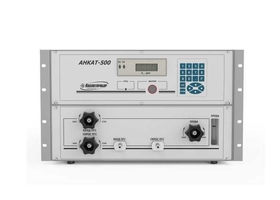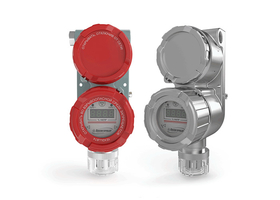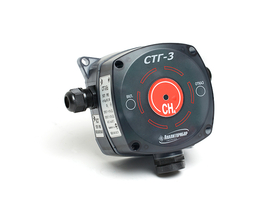- Home /
- Application /
Chemistry

A lot of gas analysis tasks are to be solved at every place of chemical production. These tasks can be divided into general and special.
General tasks are the tasks that are not changed depending on the end product manufactured by the chemical industry enterprise. These are standard safety tasks:
- monitoring of maximum permissible concentrations of toxic gases in working area;
- monitoring of pre-explosive concentrations of flammable gases and vapors;
- monitoring of excess/lack of oxygen;
and standard tasks of technological processes control:
- continuous monitoring of oxygen purity (0—2 vol. % H2 in O2) and hydrogen (0—1vol. % O2 in H2) – water decomposition products with the use of electrolysis method at electrolysis station;
- continuous monitoring of purity of oxygen (98—100 vol. % O2) and nitrogen (trace concentration of oxygen in N2) – air separation products at oxygen separation station;
- continuous ecological monitoring of combustion gases with calculation of gross emissions;
- and others.
Except general gas analysis tasks there are special tasks. Every chemical enterprise is unique. And this originality depends on the type of manufactured end product; technological production cycle; type of installed equipment etc. That is why every chemical production requires unique and nontrivial solutions for gas analysis of the products formed during production.
As an example, ammonia production process is presented. Ammonia is produced by means of processing of atmospheric nitrogen and natural gas; atmospheric nitrogen fixation in the form of ammonia complies with the following equation:
N2+3H2=2NH3+2Q,
where Q – thermal effect of ammonia synthesis reaction.
Ammonia production technology is described below:
- hydrogen production by means of natural gas conversion that takes place in pipe furnaces under pressure of 30—40 atm. and at a temperature of 525 °C. After a pipe furnace, in the first stage, continuous automatic monitoring of residual methane in the range from 0 to 10 vol. % (usually up to 9 vol. % CH4 remains) is required; in the second stage temperature rises up to 850 °C and residual methane conversion takes place. At the output of the second stage we have a convertible gas of the following content: hydrogen 60—66.5 vol. %, nitrogen 20—22.4 vol. %, methane 0.5 vol. %, carbon monoxide — up to 10 vol. %, carbon dioxide 7—9 vol. %, water vapors;
- produced convertible gas is subjected to several cleaning stages:
- desulfurization, catalyst poisons removal. Usually it has two stages: the first stage is hydrogenation up to H2S at a temperature of 350—400 °C and pressure 2—4 MPa; the second stage is absorption at a temperature of 200—500 °C;
- the following stage is CO conversion. The first stage takes place in reactor at a temperature of 280—420 °C, after that not more than 3.6 vol. %. CO remains in convertible gas. In this case it is required to perform continuous automatic monitoring of CO in the range from 0 to 10 vol. %. As a result of the second stage, not more than 0.5 vol. % of carbon monoxide must remain after reactor; continuous automatic monitoring of CO in the range from 0 to 1 vol. % is required;
- cleaning from nitrogen compounds (NO and NO2) is carried out at a temperature of 180—320 °C using aluminum-manganese catalysts;
- cleaning from CO2 is carried out by means of absorption with 20%-solution of monoethanolamine HO-CH2CH2-NH2 (MEA) at a pressure of 1—3 MPa; residual concentration of CO2 is not more than 0.01—0.1 vol. %;
- methanation is a fine cleaning from CO and CO2 at a temperature of 250—350 °C, and pressure 2.7—2.8 MPa over a regenerated nickel-aluminum catalyst. Continuous automatic monitoring of residual CO in the range from 0 to 100 ppm is required;
- as a result after dehumidification we obtain pure hydrogen;
- purified nitrogen-hydrogen mixture is fed to turbocompressor, and after compression up to 200—300 atm. it enters synthesis column through annular spaces between the walls. Passing through heat exchanger pipes the mixture gets to the catalyst, ammonia synthesis is carried out over it;
- resulting mixture NН3-N-Н2 passes through heat exchanger pipes and enters cooler and after that separator. Liquid ammonia separated from gas mixtures in separator enters storehouse. Mixture N-H2, that did not take part in the reaction by means of circulator, enters synthesis column, its content is controlled during discharge, blowing, synthesis, in this case control of argon is especially important, because it is a poison for catalysts; if they are poisoned, ammonia production will drop. Therefore the following parameters are continuously and automatically monitored in this mixture: N2 (up to 21 %); Н2 (up to 50—70 %); Ar (from 0 to 4 %); NН3 (up to 3 %), СН4 (up to 10 %).
It is seen from the example how difficult technological process is, and practically in all stages of ammonia production analytical gas analyzers for determination of above-listed components under different conditions of temperature, pressure and gas concentration are used.
"Analitpribor" products used for solving the following standard safety tasks:
- continuous monitoring of pre-explosive concentrations of flammable gases and vapors: for hazardous areas – ДАТ-М, ДАК with power supply units БПС-21М; for non-hazardous areas – gas alarms СТГ-3 with power supply units БПС-3
- continuous monitoring of maximum permissible concentrations of toxic gases in working area and oxygen concentration: for hazardous areas – gas analyzers ДАХ-М with power supply units БПС-21М; for non-hazardous areas – gas alarms СТГ-3 with power supply units БПС-3
- continuous monitoring of pre-explosive concentrations of flammable gases and vapors, maximum permissible concentrations of toxic gases in working area and oxygen concentration – for large area objects (the whole enterprise)- system СКАПО with the use of ДАТ-М, ДАХ-М, ДАМ, ДАК
- individual gas analyzer for monitoring of pre-explosive concentrations of flammable gases and vapors – СГГ-20Микро
- individual gas analyzer for monitoring of maximum permissible concentrations of toxic gases in working area and oxygen concentration – АНКАТ-7631Микро
- portable device for periodic monitoring of pre-explosive concentrations of flammable gases, maximum permissible concentrations of toxic gases in working area and excess/lack of oxygen (up to 4 gases simultaneously, in different combinations) – АНКАТ-7664Микро
"Analitpribor" products used for solving the following standard technology tasks:
- continuous monitoring of purity of O2 and H2 – gas analyzers ДАМ with power supply units БПС-21М
- monitoring of oxygen trace concentrations (nitrogen purity) – АНКАТ-500
- continuous ecological monitoring of combustion gases with calculation of gross emissions – sets of gas-analysis equipment (КГО) with the use of devices ГАММА-100 and sample preparation elements
"Analitpribor" products used for solving the following special gas analysis tasks:
- on the customer's request in accordance with technical conditions of a definite industrial enterprise one or several sets of gas-analysis equipment are designed with the use of ГАММА-100, stream chromatographs, mass spectrometers and other devices and sample preparation elements.





